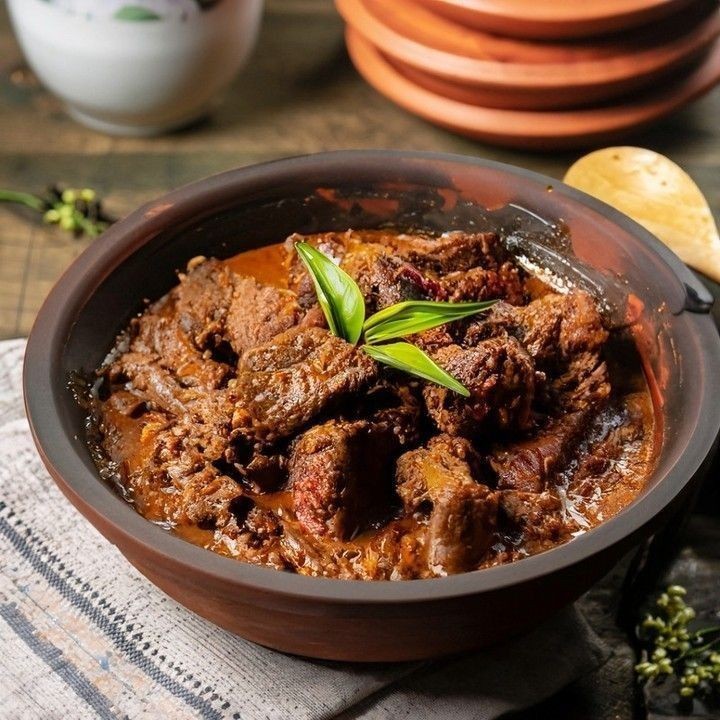
Rendang: The Pride of Indonesia and the World’s Most Flavorful Dish
LoveFoodReadyMeals – Few dishes on Earth can match the richness, history, and emotion of Rendang, Indonesia’s most celebrated culinary treasure. Born in the lush highlands of West Sumatra, Rendang is more than food — it’s a story of patience, pride, and tradition. In 2011 and again in 2017, CNN International crowned it the World’s Most Delicious Food, confirming what Indonesians have always known.
Each bite of Rendang carries memories of community gatherings and ancestral wisdom. Beyond taste, it embodies the Indonesian spirit — one that values harmony, gratitude, and togetherness.
The Origin: From Tradition to Global Fame
Rendang’s roots reach deep into the Minangkabau culture of West Sumatra. For centuries, families have cooked it during ceremonies, weddings, and festivals to honor guests. This dish, simmered slowly in coconut milk and aromatic spices, was originally developed to preserve meat for long journeys. Before refrigeration existed, the technique allowed the dish to stay fresh for weeks.
As Minangkabau traders and travelers spread across Indonesia and Southeast Asia, they carried Rendang with them. Consequently, it found homes in Malaysia, Singapore, Brunei, and parts of Thailand. Despite regional twists, the essence of Rendang — patience and precision — remains the same. Today, UNESCO recognizes it as part of Indonesia’s intangible cultural heritage, a symbol of the country’s culinary brilliance.
“Read More : How to Identify Real Pearls from Fake Ones, Avoid Getting Tricked”
The Art of Slow Cooking: Patience Meets Perfection
Cooking Rendang requires time, care, and unwavering attention. Traditionally, cooks use tender beef simmered for hours in coconut milk, lemongrass, galangal, garlic, ginger, turmeric, and chili. Over time, the sauce thickens and caramelizes, coating the meat with a rich, spicy glaze.
The process unfolds in three stages — wet Rendang (Kalio), semi-dry Rendang, and dry Rendang. Each phase offers distinct flavor and texture. As the liquid reduces, the spices intensify, creating an unmatched depth. Locals often say, “Rendang isn’t just cooked — it’s nurtured.” The long hours reflect values cherished in Indonesian culture: patience, discipline, and love.
Spices: The Heartbeat of Rendang
Every spoonful of Rendang delivers a perfect balance of spice, heat, and aroma. The magic lies in the bumbu, a spice blend combining shallots, garlic, ginger, chili, kaffir lime leaves, and cinnamon. Each ingredient carries symbolic meaning and cultural significance.
- Turmeric signifies purity and prosperity.
- Coconut milk reflects unity and harmony.
- Chili symbolizes bravery and resilience.
- Salt reminds people of balance in life.
Together, these elements express the Minangkabau philosophy, Alam Takambang Jadi Guru, meaning “nature is the ultimate teacher.” Thus, Rendang isn’t just delicious — it’s a spiritual experience where nature and tradition unite on a plate.
“Read More : Indian Curry and Health: Nutritional Benefits of Spices and Ingredients”
Regional Variations: One Dish, Many Stories
Across Indonesia, Rendang takes on local flavors and stories. In Padang, the dish turns dark, dry, and rich — perfect for storage and travel. Meanwhile, in Java, people prefer a sweeter version with hints of palm sugar. In Aceh and Riau, extra chilies create a fiery kick.
Beyond Indonesia, neighbors like Malaysia and Singapore have embraced their own versions. For example, Malaysia’s Rendang Tok is thicker and oilier, while Singapore often replaces beef with chicken or lamb. Even with these differences, every version pays homage to the same slow-cooking tradition and dedication to flavor.
Rendang as a Symbol of Love and Togetherness
Cooking Rendang is more than a culinary act — it’s a communal ritual. Families gather to stir large pots for hours, sharing laughter and stories as the rich aroma fills the air. The process strengthens bonds and reflects the Indonesian value of gotong royong, or working together in harmony.
In Minangkabau philosophy, Rendang also symbolizes social structure. The beef represents leaders, coconut milk stands for scholars, chilies symbolize spiritual leaders, and spices represent the community. Together, they embody balance, cooperation, and mutual respect — the same principles that guide Indonesian society.
Global Recognition and Modern Reinvention
Over time, Rendang has traveled far beyond Indonesia’s borders. It has appeared in Michelin-starred restaurants, international food festivals, and countless YouTube cooking shows. Its complex layers of spice and texture have captivated food lovers worldwide.
Today, chefs are reinventing Rendang in creative ways — from Rendang burgers to vegan jackfruit Rendang. Although traditionalists prefer the original, these innovations prove that Rendang’s spirit adapts without losing its authenticity. Whether served in a warung in Padang or a fine-dining restaurant in London, Rendang continues to represent Indonesia’s soul in every bite.